
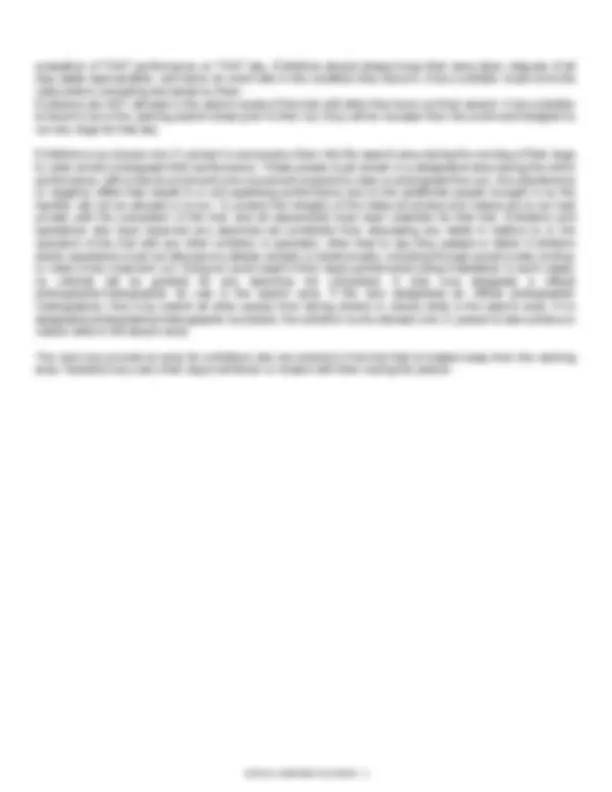
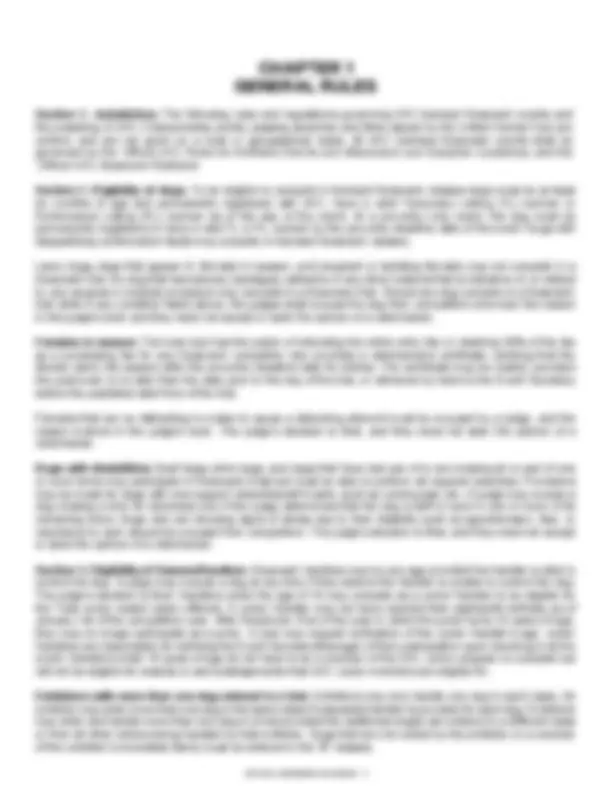
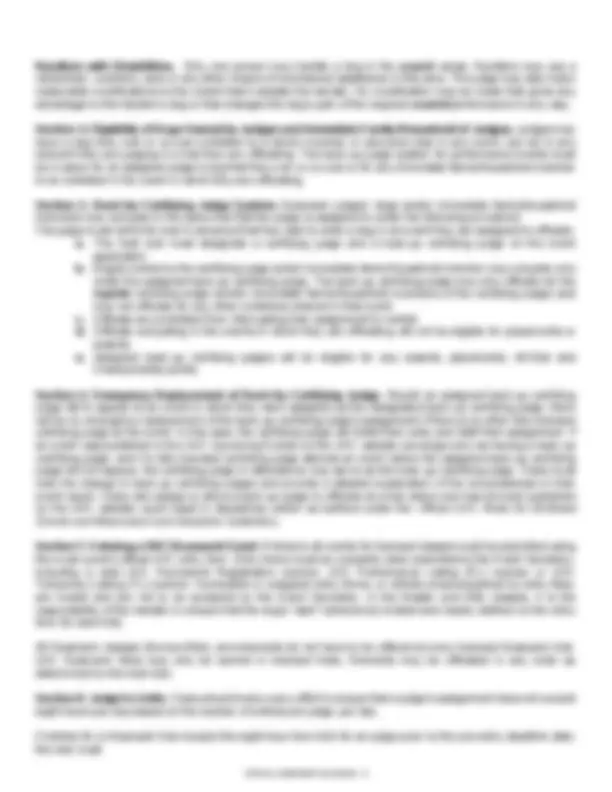
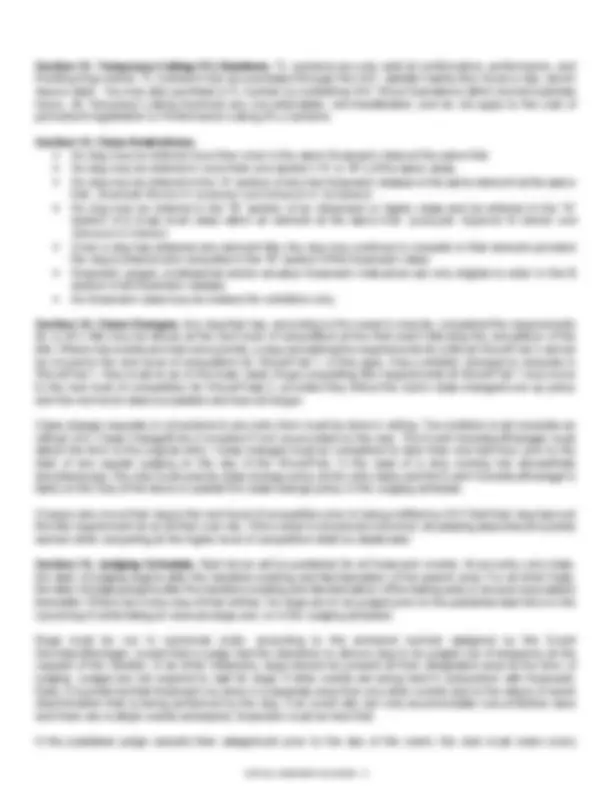
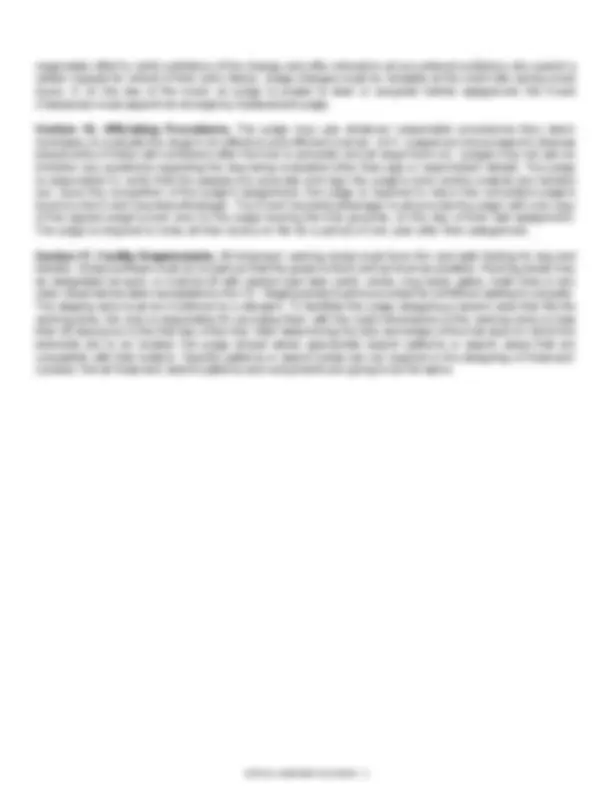
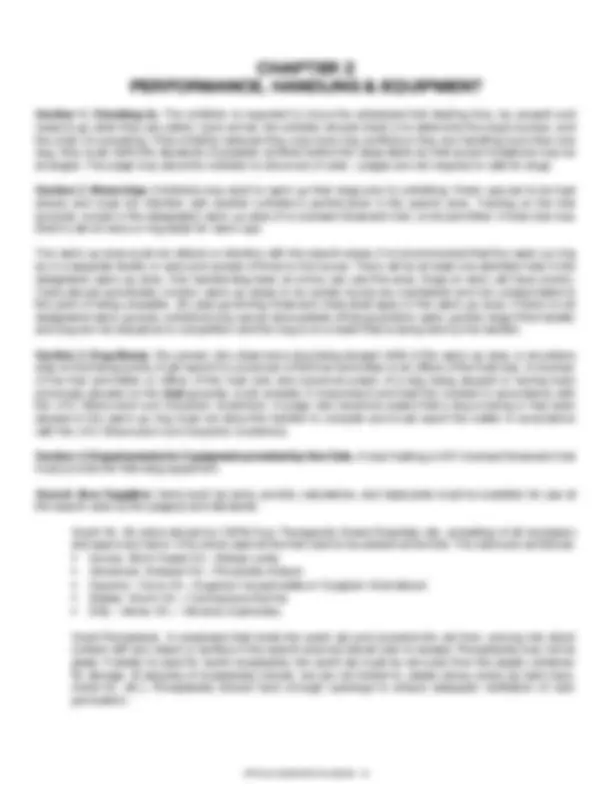
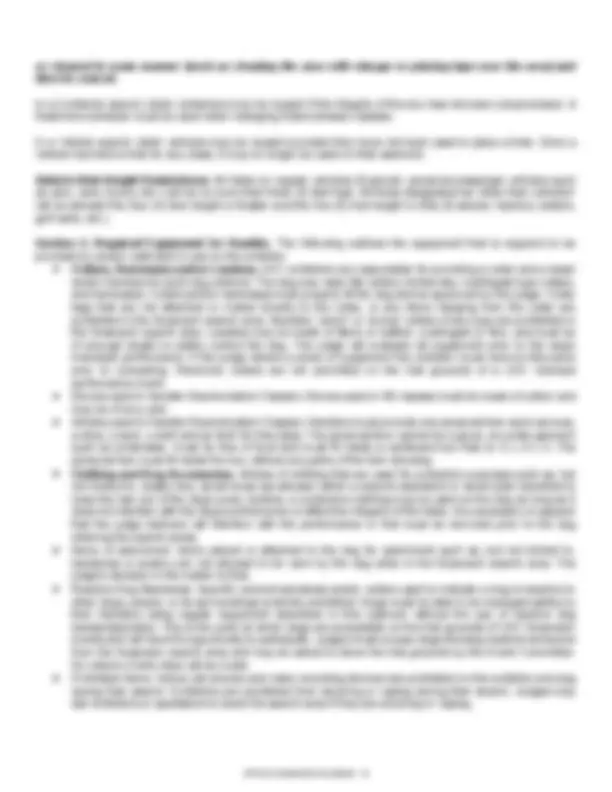
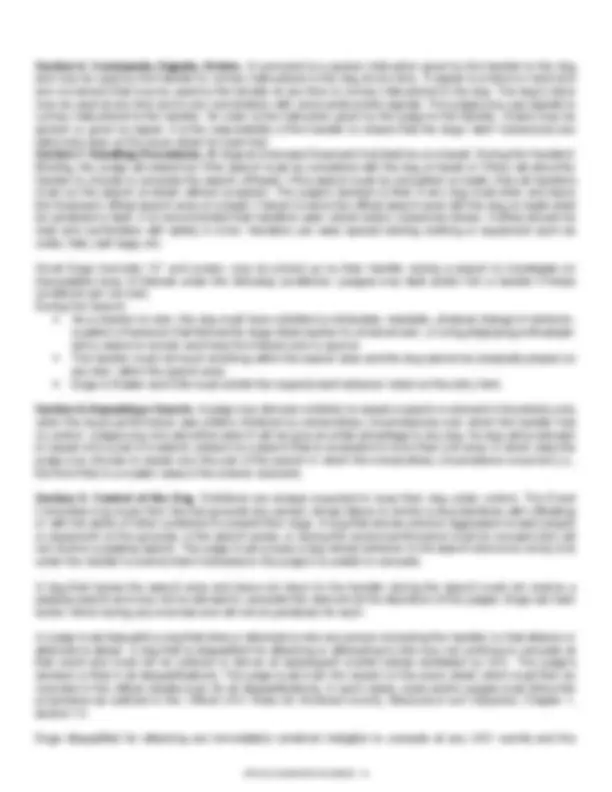
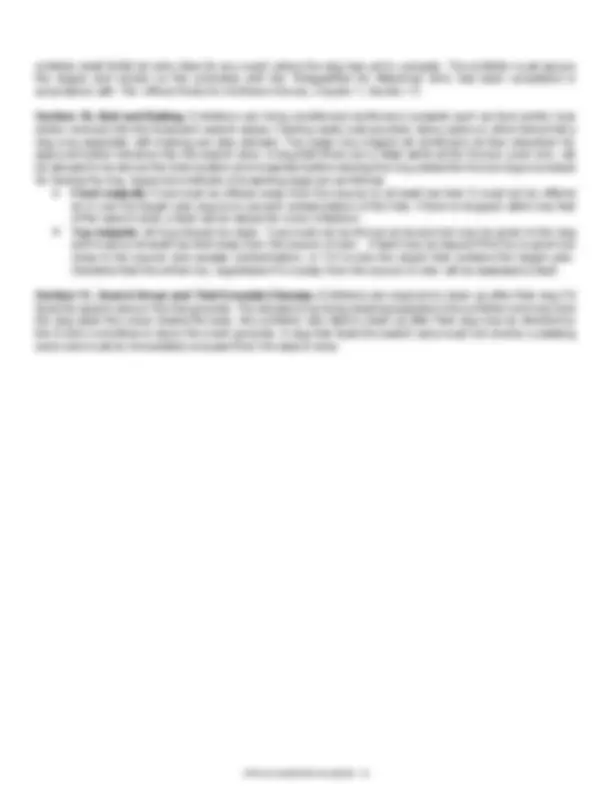
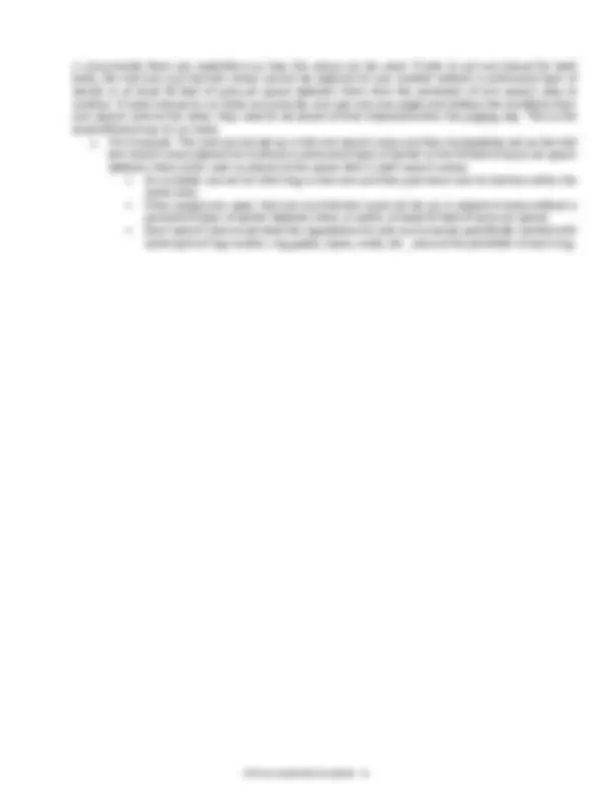
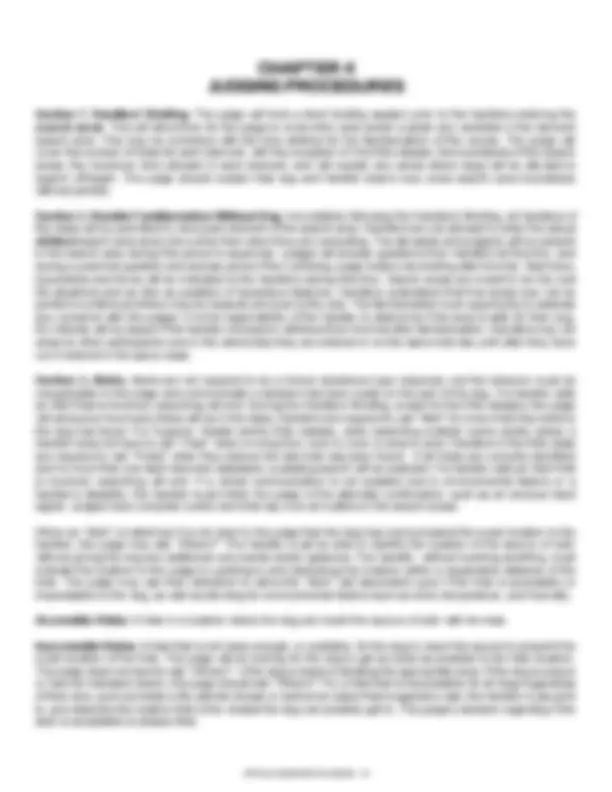
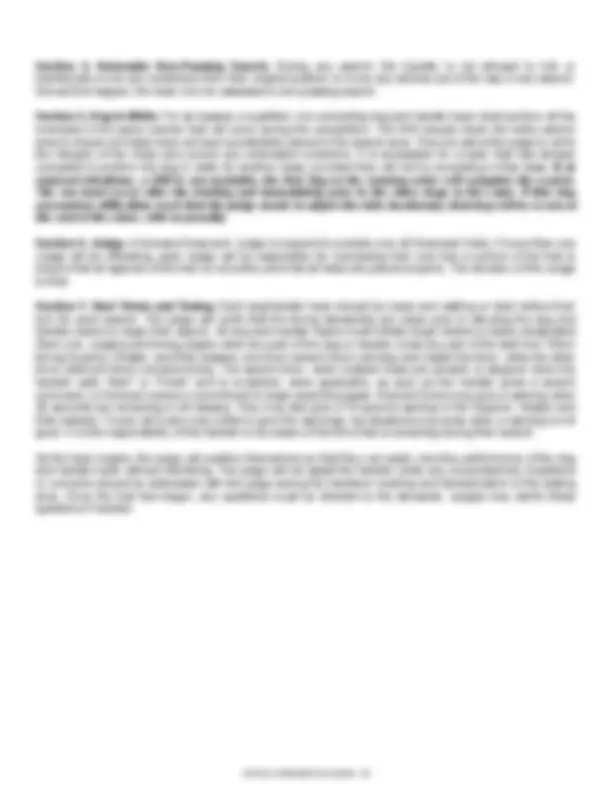
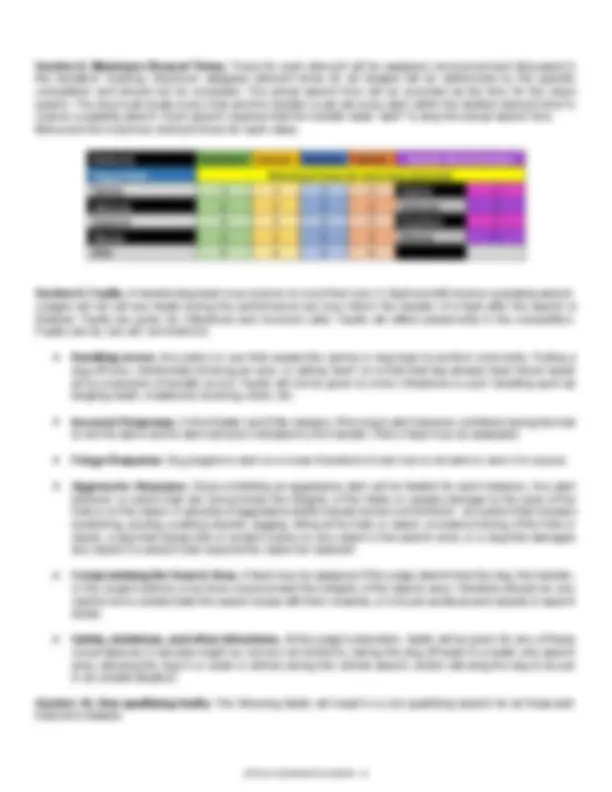
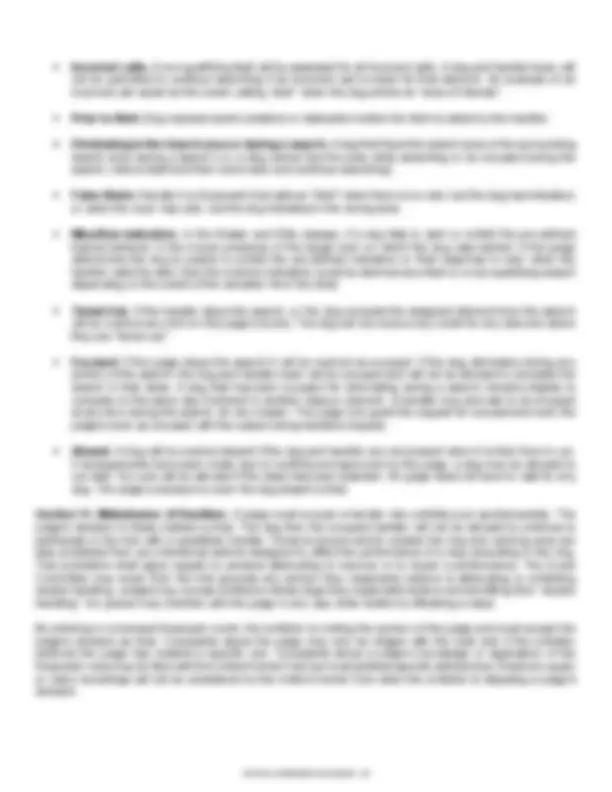
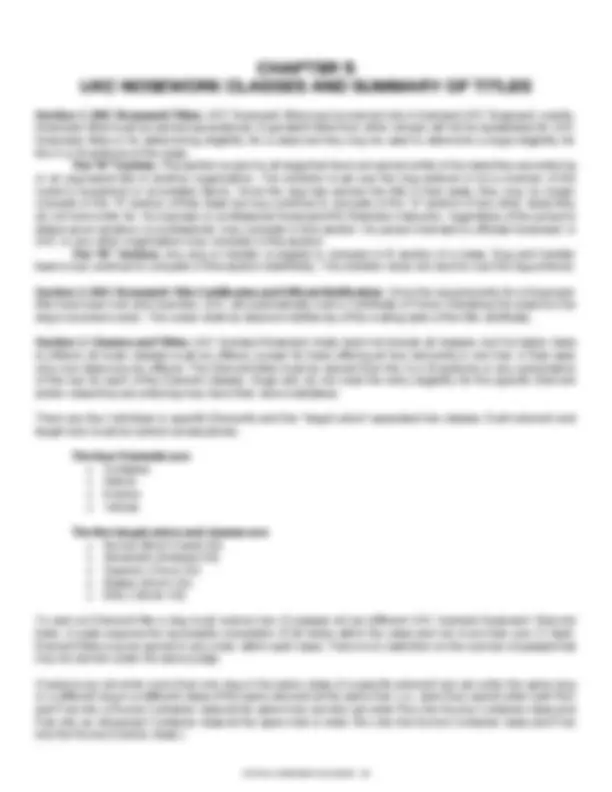
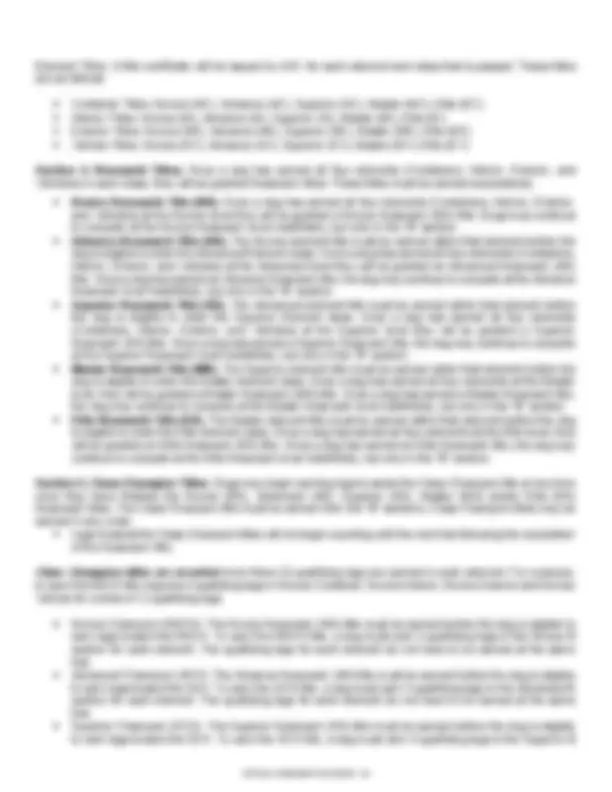
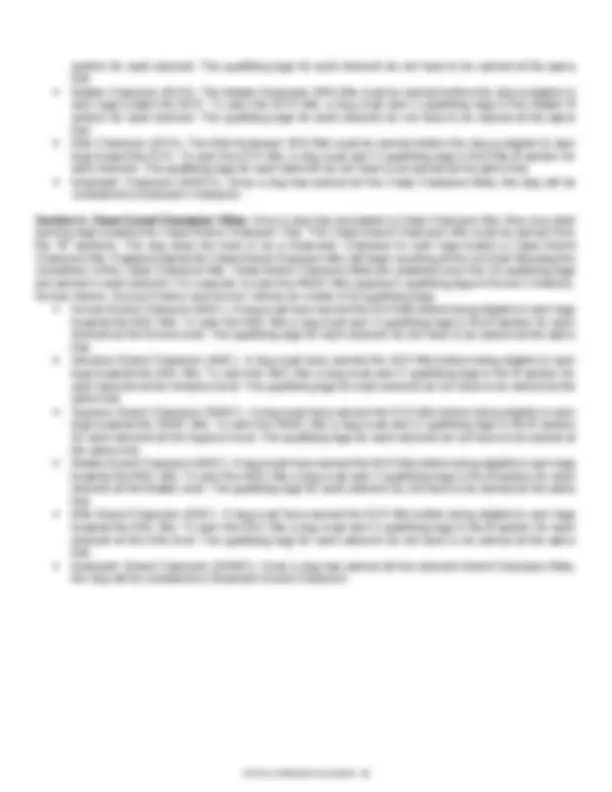
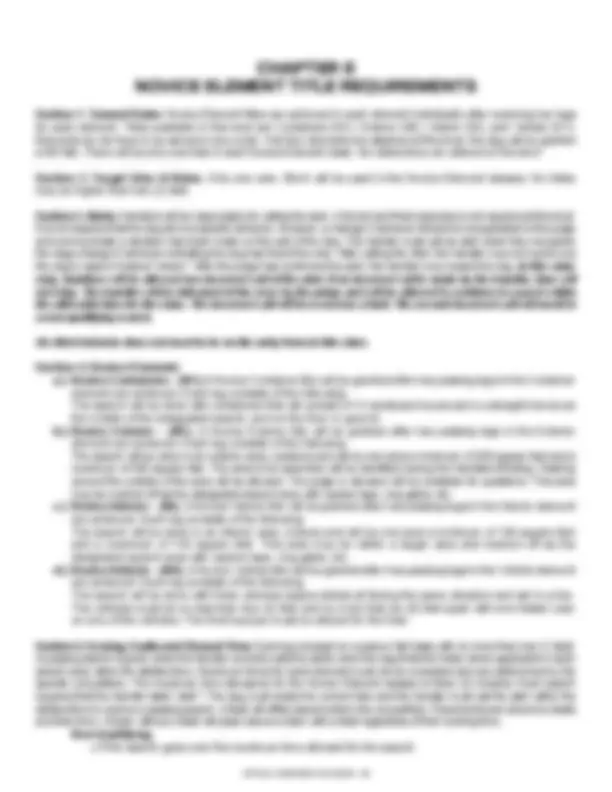
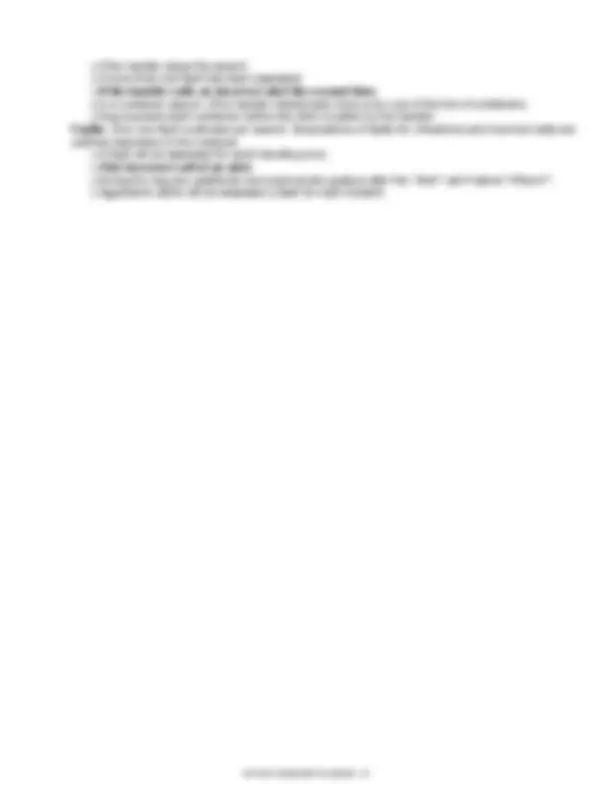
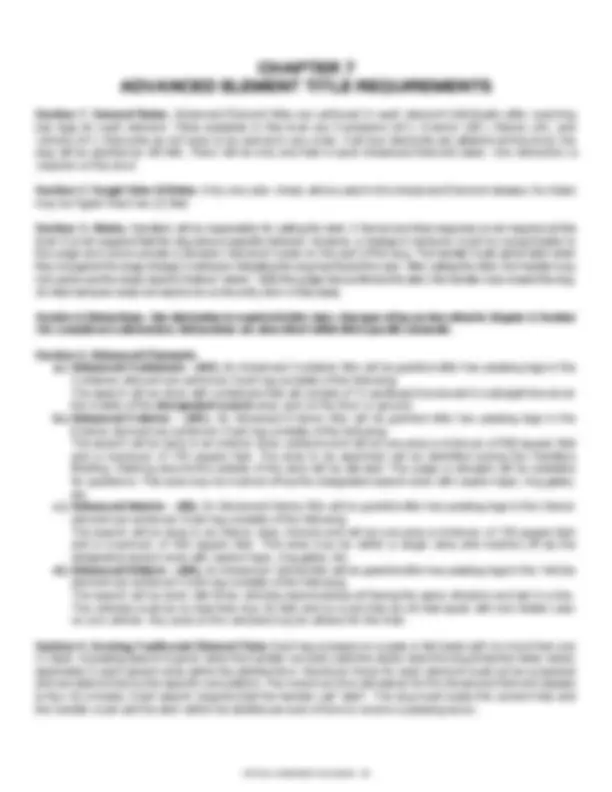
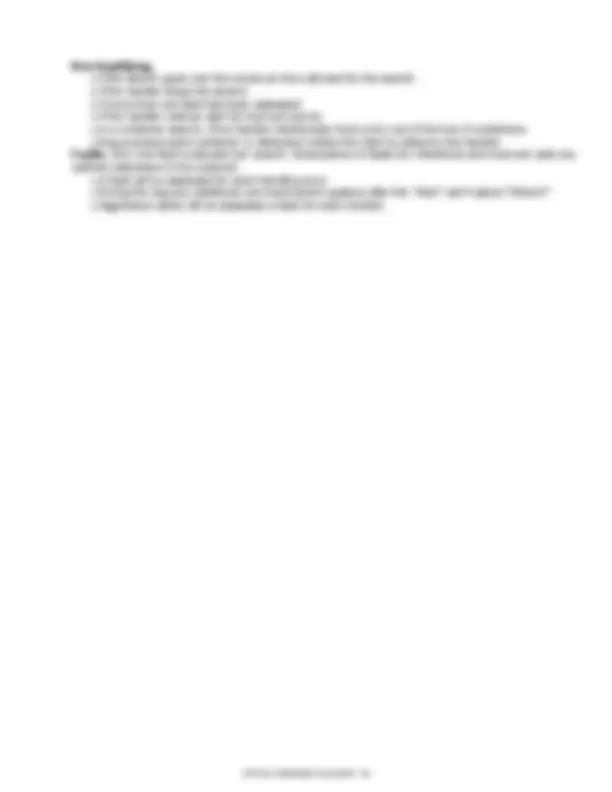
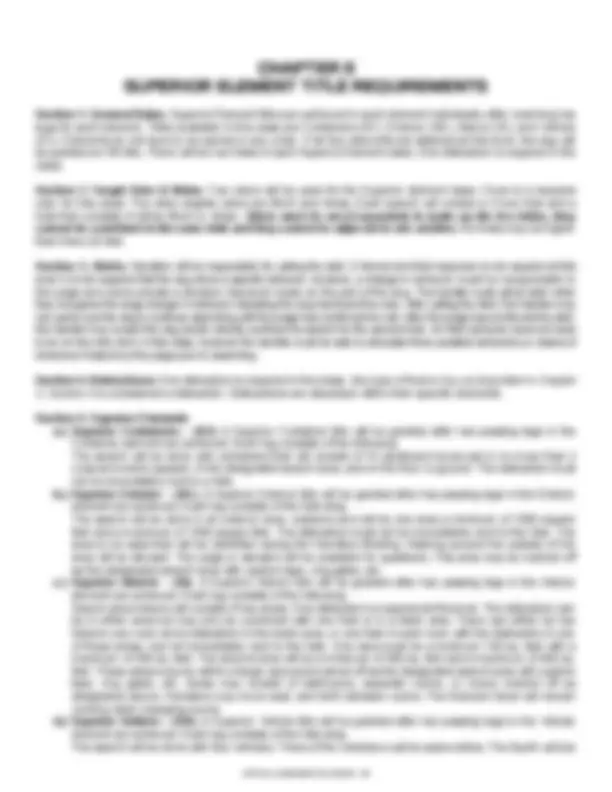

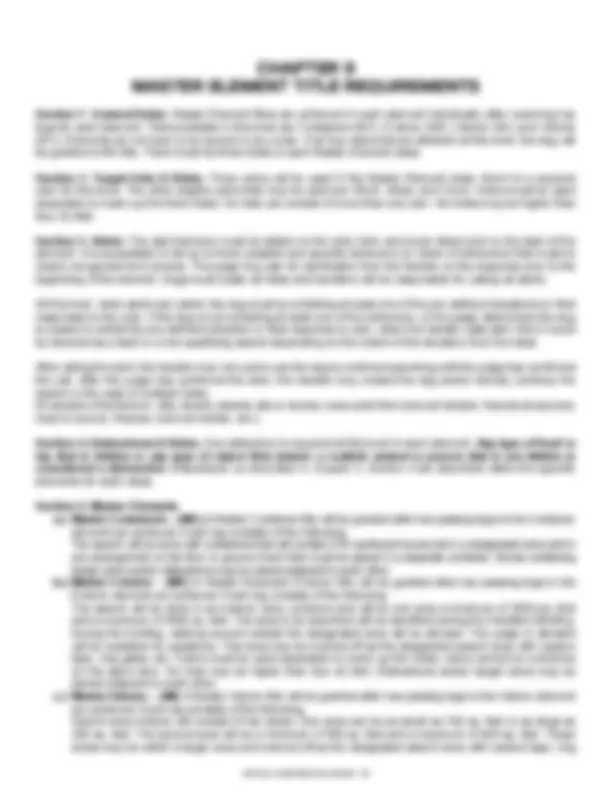
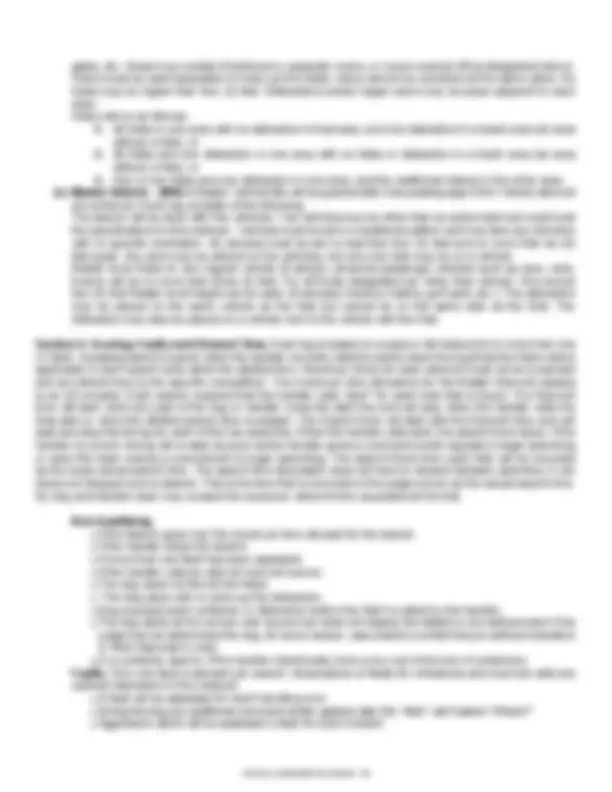
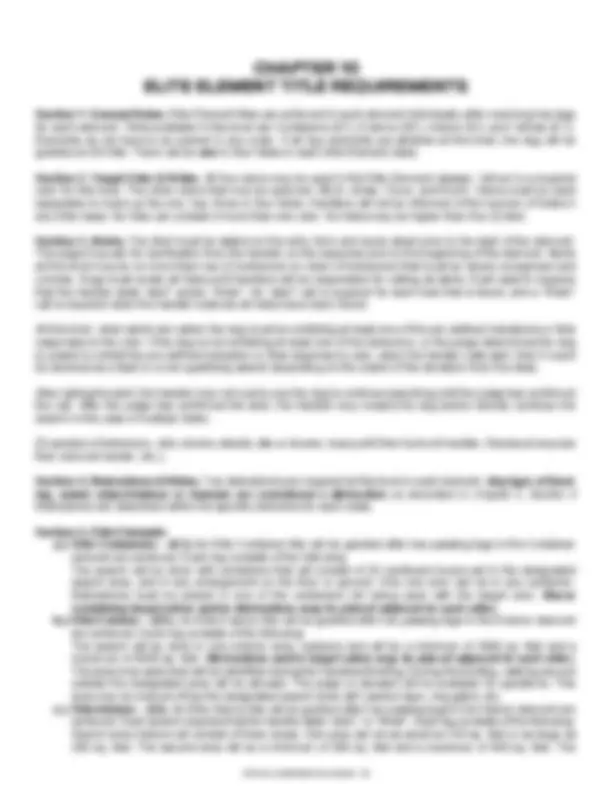
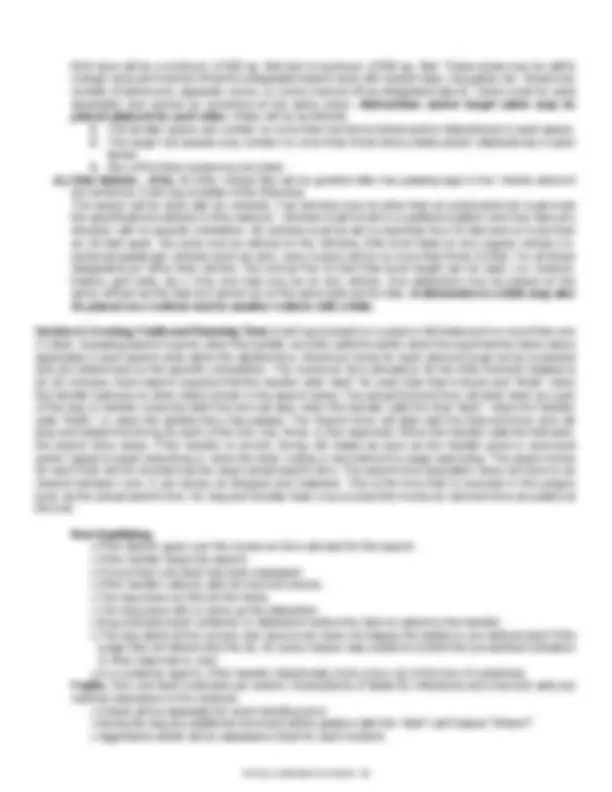
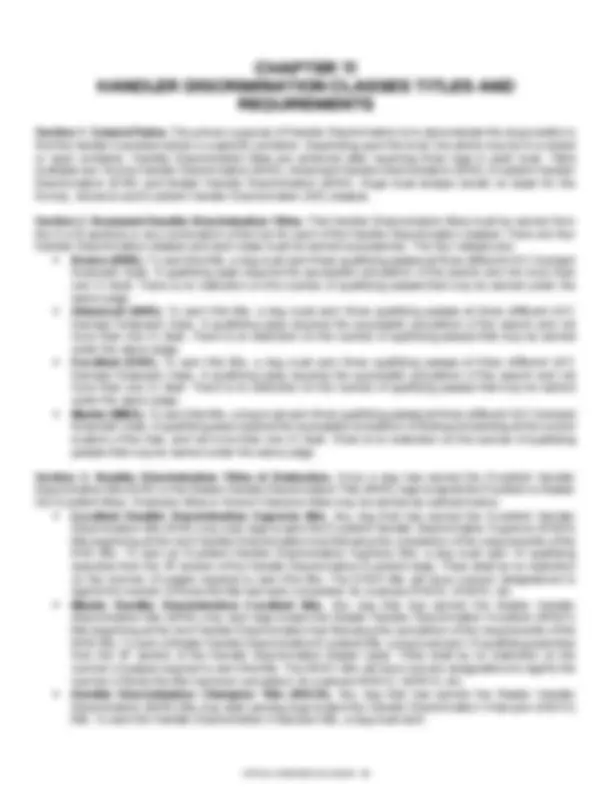
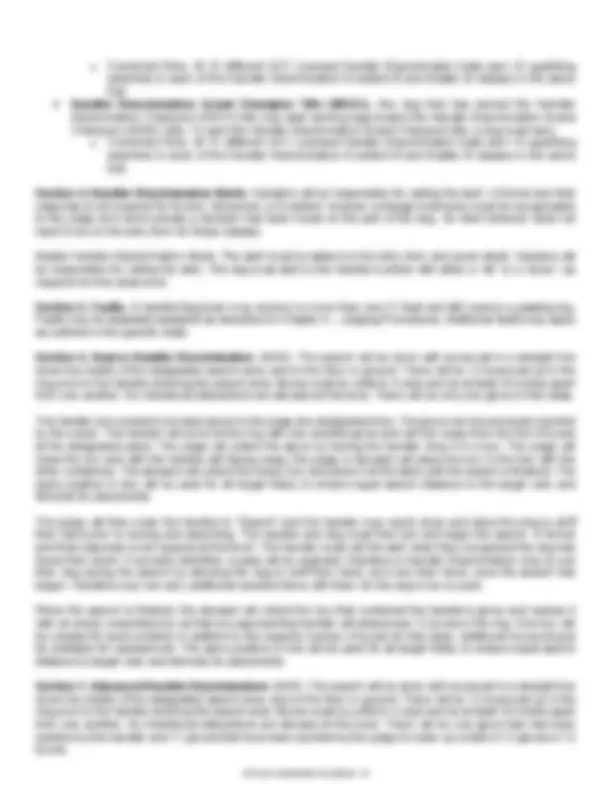
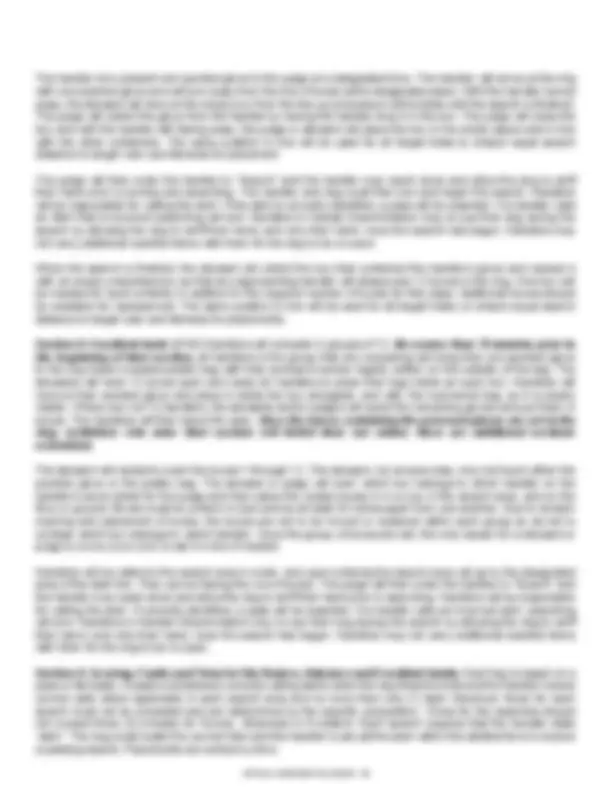
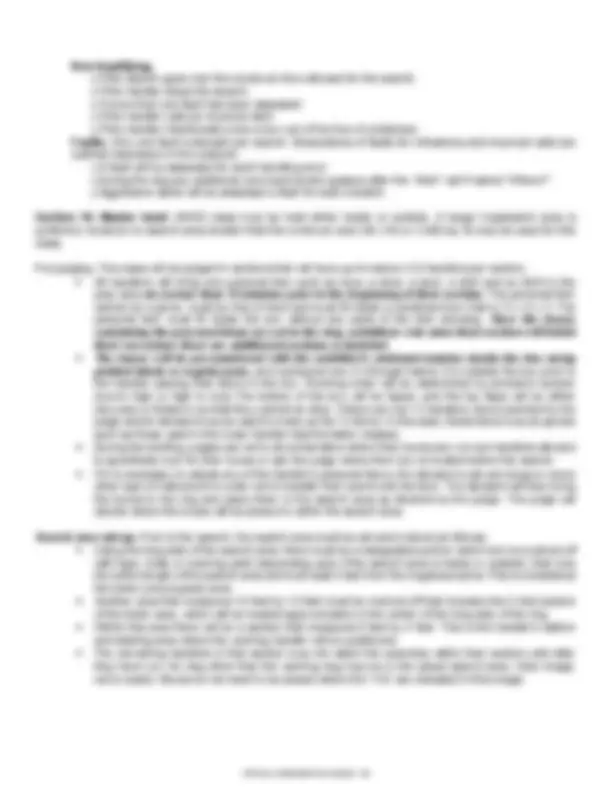
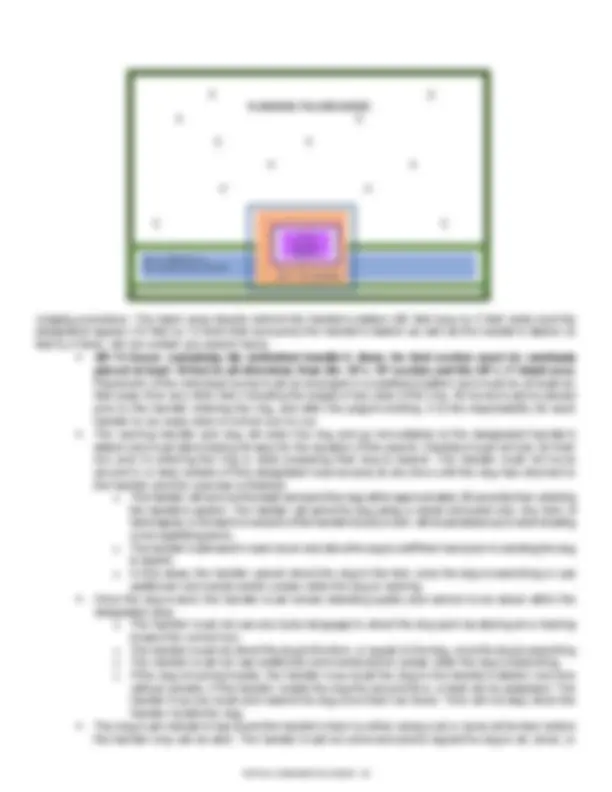
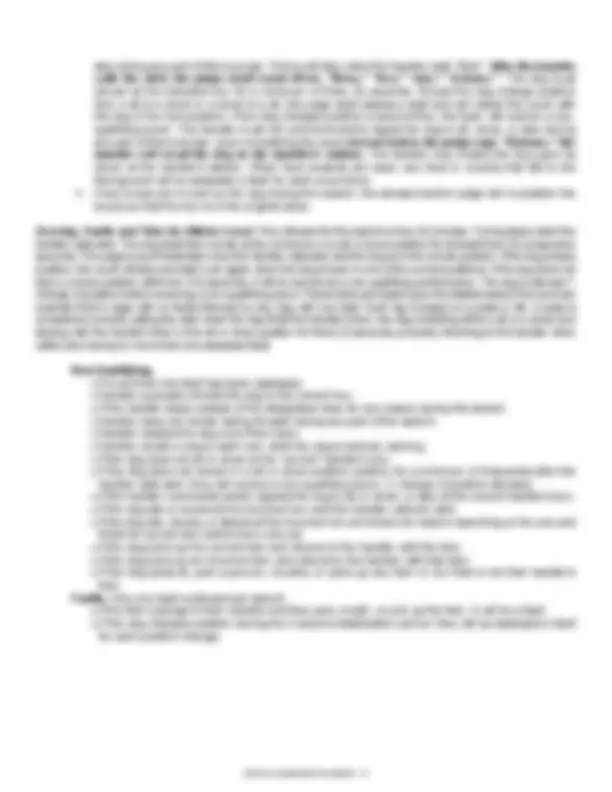
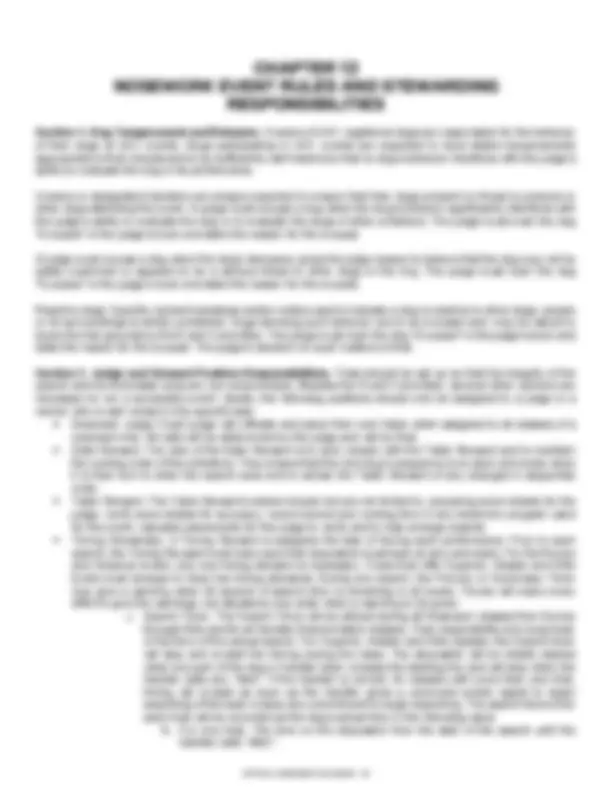
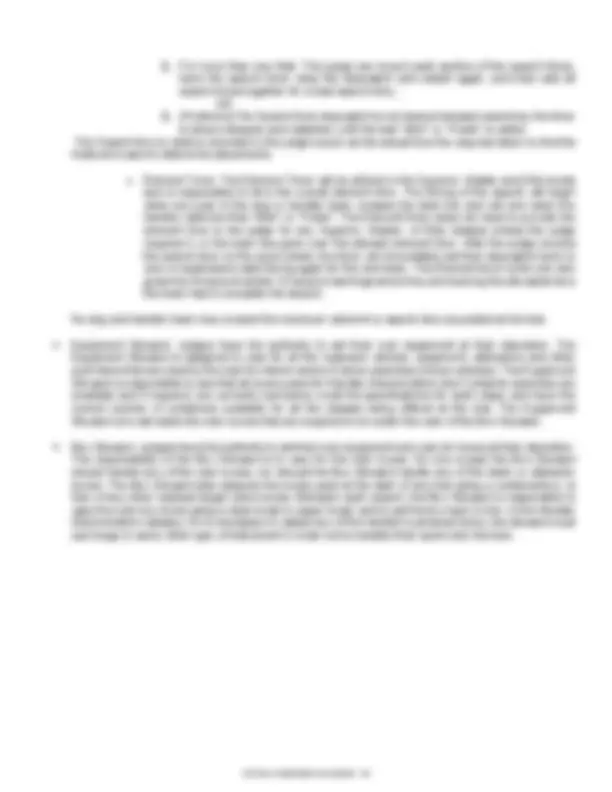
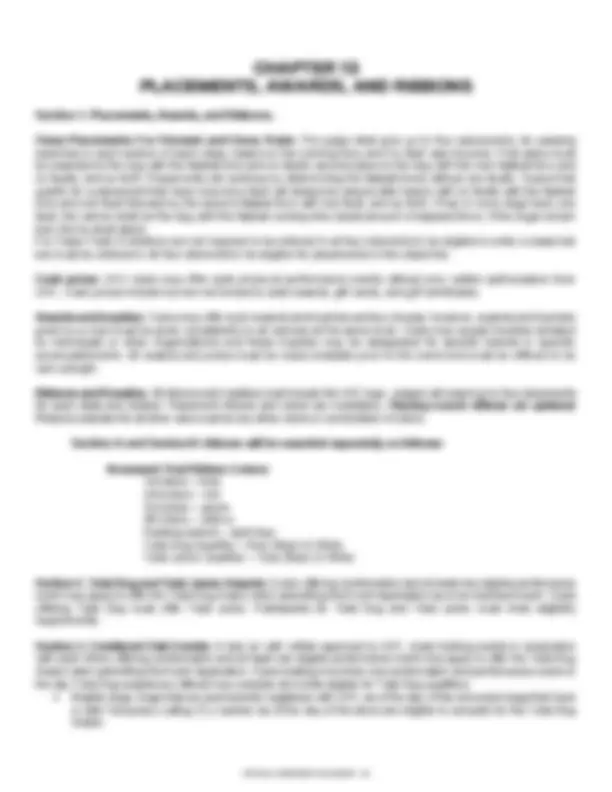
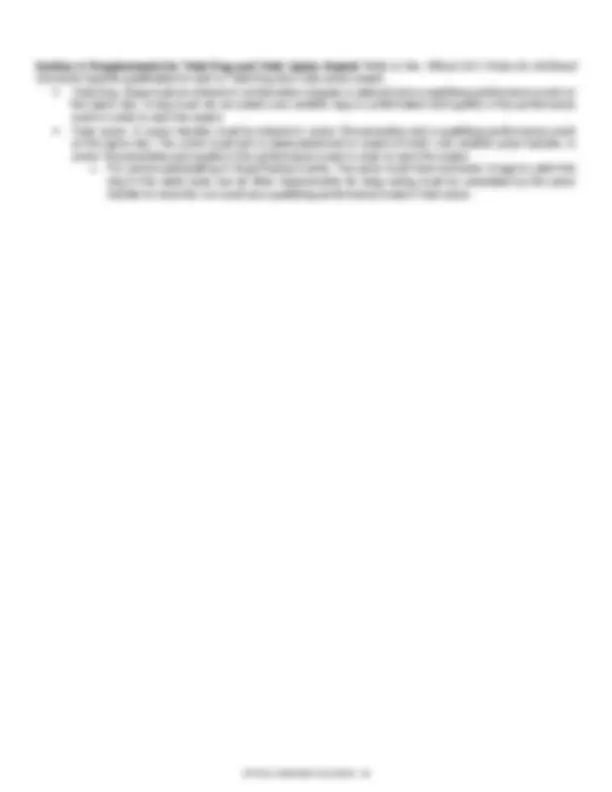
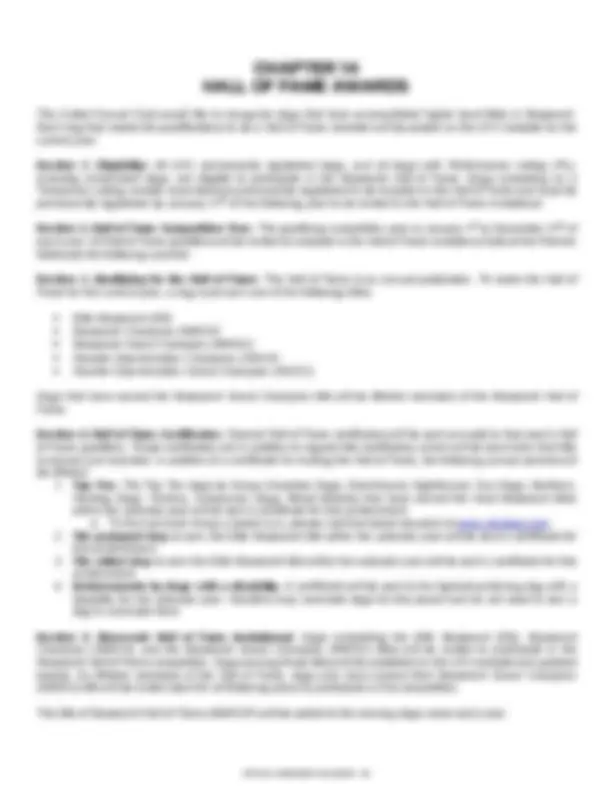
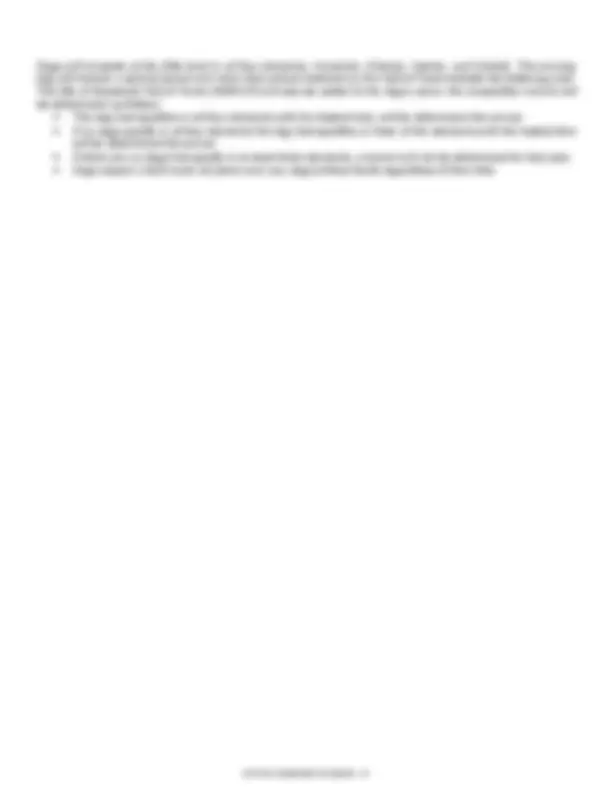
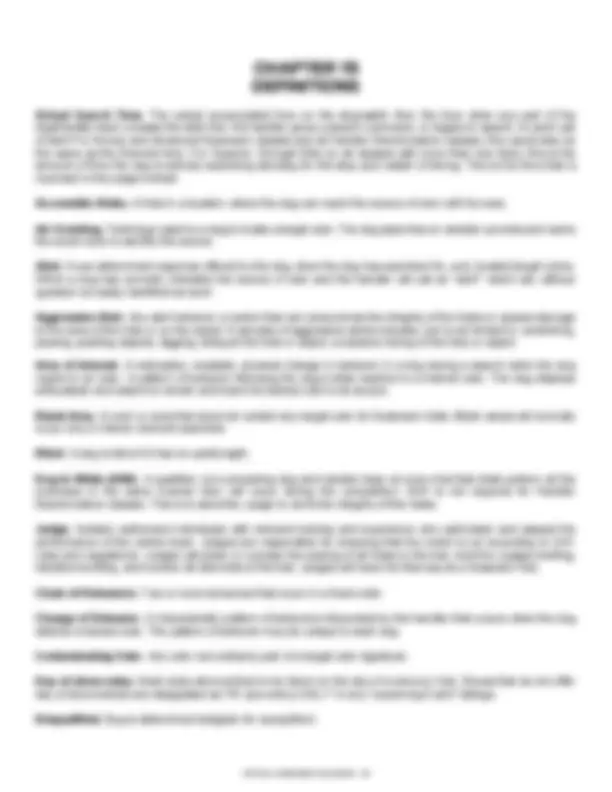
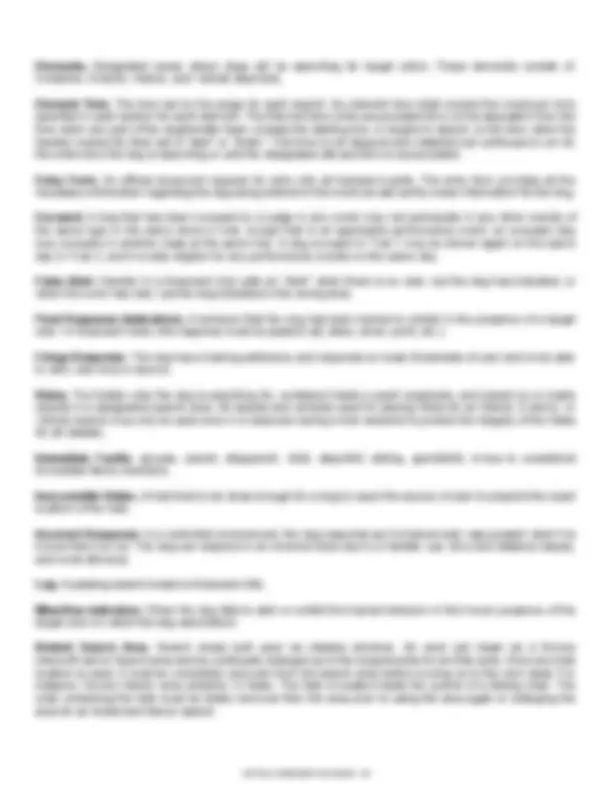
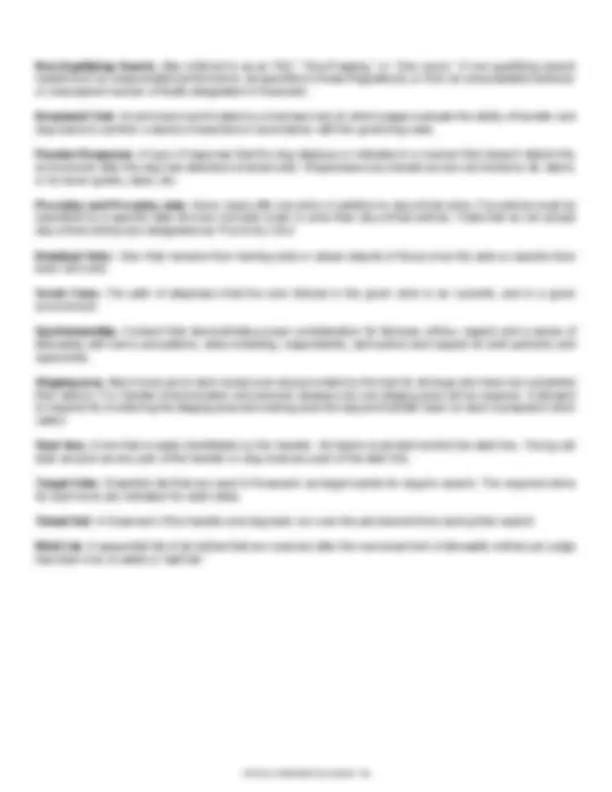
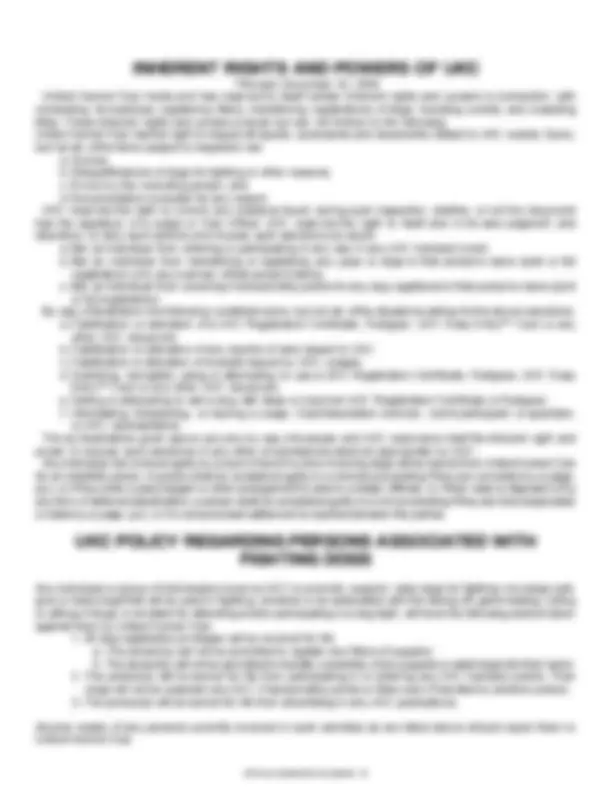
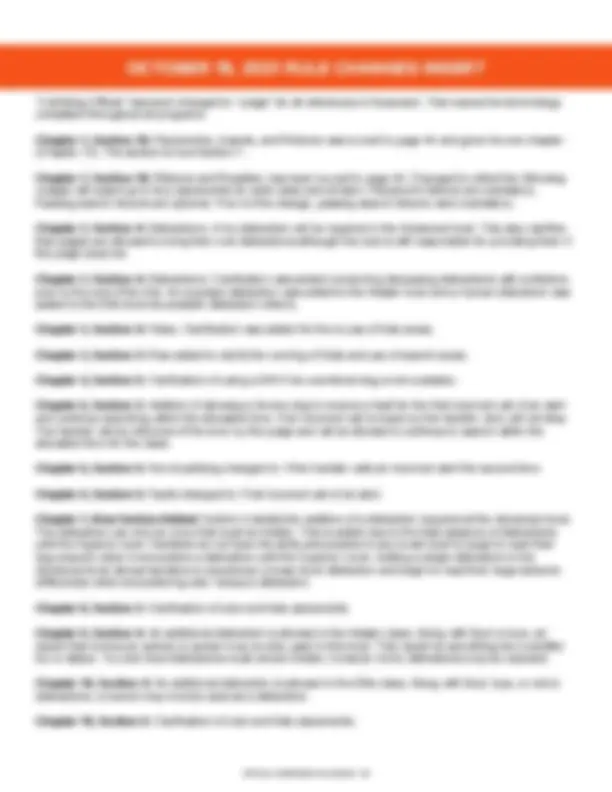
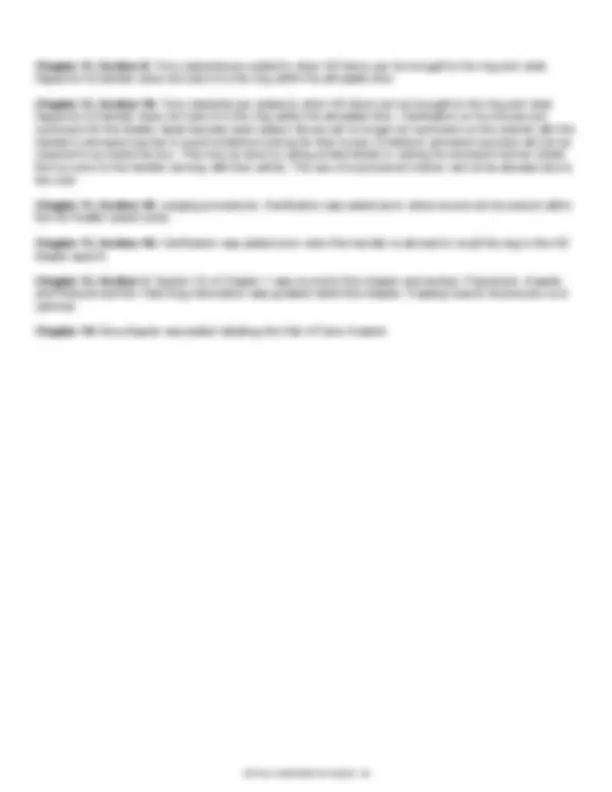


Study with the several resources on Docsity

Earn points by helping other students or get them with a premium plan


Prepare for your exams
Study with the several resources on Docsity

Earn points to download
Earn points by helping other students or get them with a premium plan
Community
Ask the community for help and clear up your study doubts
Discover the best universities in your country according to Docsity users
Free resources
Download our free guides on studying techniques, anxiety management strategies, and thesis advice from Docsity tutors
The rules and regulations governing UKC licensed Nosework events, including eligibility, conduct of trials, and awarding of titles. It also includes the official UKC Nosework Rulebook and misconduct and discipline guidelines.
What you will learn
Typology: Exams
1 / 53

This page cannot be seen from the preview
Don't miss anything!














































The United Kennel Club would like to thank Karen A. Shivers for her continued dedication to the sport of dogs and the promotion of Nosework. It is her contribution and determination to make Nosework available for every UKC® dog and handler that has made UKC Nosework grow.
Table of Contents Rules for Nosework Competition .............................................................................................................. Chapter 1 – General Rules ....................................................................................................................... Chapter 2 – Performance, Handling & Equipment .................................................................................... Chapter 3 – Search / Area Size and Element Requirements .................................................................... Chapter 4 – Judging Procedures .............................................................................................................. Chapter 5 – UKC Nosework and Summary of Titles ................................................................................. Chapter 6 – Novice Element Classes and Requirements.......................................................................... Chapter 7 – Advanced Element Classes and Requirements ..................................................................... Chapter 8 – Superior Individual Classes and Requirements ..................................................................... Chapter 9 – Master Element Classes and Requirements.......................................................................... Chapter 10 – Elite Element Classes and Requirements............................................................................ Chapter 11 – Handler Discrimination Classes, Titles & Requirements ...................................................... Chapter 12 – Nosework Event Rules and Stewarding Responsibilities ..................................................... Chapter 13 – Placements, Awards, and Ribbons ...................................................................................... Chapter 14 – Hall of Fame Awards ........................................................................................................... Chapter 15 – Definitions .......................................................................................................................... Inherent Rights & Powers of UKC............................................................................................................. UKC Policy Regarding Persons Associated with Fighting Dogs ................................................................ October 20, 2021 Rule Change Insert ......................................................................................................
UKC is the trademark of the United Kennel Club located in Kalamazoo, Michigan. The use of the initials UKC in association with any other registry would be in violation of the registered trademark. Notify the United Kennel Club, 100 E Kilgore Rd, Kalamazoo MI 49002-5584, should you become aware of such a violation.
Rules for Nosework Competition Nosework is an uninterrupted performance by the dog and handler without direction from the judge. The arrangement of the searches that are found in Nosework are randomly chosen and are like single purpose K- detection dogs whose duties include searching for drugs and explosives, locating missing people and finding crime scene evidence. The Nosework team is evaluated on their ability to search for, locate, and respond to, target odors defined by the UKC Nosework Rulebook.
The overall performance should convey an image of fun, enthusiasm and the ability of the team to work in partnership. Nosework is meant for all breeds and types of dogs. It enables them to use their natural olfactory abilities to work in partnership with their handler and to respond to specific target odors modeled after working detection dogs. This activity provides a safe and enriching environment, can be easily performed in a wide variety of locations, and builds a trusting and lasting relationship between handler and dog.
The concept of Nosework is meant for all dogs and handlers no matter their physical abilities and structure. All dogs under reasonable control as determined by the judge should be able to participate in Nosework events. Nosework allows unlimited communication between dog and handler. The Judge should only be concerned with the overall execution and completion of each exercise.
Exhibitor Guidelines. It is the responsibility of all exhibitors to do whatever they can to assist the host club and promote the family atmosphere of UKC events and good sportsmanship. Exhibitors’ clothing should be neat and clean. Their apparel speaks to the respect they have for the sport, the event and its proceedings. Exhibitors’ dogs should be clean and, where necessary, brushed or trimmed to present a neat appearance. Experienced exhibitors should try to help new exhibitors. Beginners are critical to the future of the sport. All exhibitors must display good sportsmanship and respect for others. Exhibitors should take care when discussing a score/placement with the judge and accept the decision of the judge gracefully. Remember, it was the judge’s
Section 1. Jurisdiction. The following rules and regulations governing UKC licensed Nosework events and the awarding of UKC Championship points, passing searches and titles issued by the United Kennel Club are uniform and are not given on a local or geographical basis. All UKC licensed Nosework events shall be governed by the Official UKC Rules for All-Breed Events and Misconduct and Discipline Guidelines , and the Official UKC Nosework Rulebook.
Section 2. Eligibility of dogs. To be eligible to compete in licensed Nosework classes dogs must be at least six months of age and permanently registered with UKC, have a valid Temporary Listing (TL) number or Performance Listing (PL) number as of the day of the event. At a pre-entry only event, the dog must be permanently registered or have a valid TL or PL number by the pre-entry deadline date of the event. Dogs with disqualifying conformation faults may compete in licensed Nosework classes.
Lame dogs , dogs that appear ill, females in season, and pregnant or lactating females may not compete in a Nosework trial. No dog that has sutures, bandages, adhesive or any other material that is indicative of, or related to, any surgical or medical procedure may compete in a Nosework trial. Should any dog compete in a Nosework trial while in any condition listed above, the judges shall excuse the dog from competition and mark the reason in the judge’s book and they need not accept or seek the opinion of a veterinarian.
Females in season: The host club has the option of refunding the entire entry fee or retaining 50% of the fee as a processing fee for any Nosework competitor who provides a veterinarian’s certificate verifying that the female came into season after the pre-entry deadline date for entries. The certificate may be mailed, provided the post-mark is no later than the date prior to the day of the trial, or delivered by hand to the Event Secretary before the published start time of the trial.
Females that are so distracting to males to cause a disturbing element must be excused by a judge, and the reason marked in the judge’s book. The judge’s decision is final, and they need not seek the opinion of a veterinarian.
Dogs with disabilities: Deaf dogs , blind dogs, and dogs that have lost use of or are missing all or part of one or more limbs may participate in Nosework trials but must be able to perform all required searches. Provisions may be made for dogs with rear support wheelchairs/K9 carts, such as running last, etc. A judge may excuse a dog missing a limb for lameness only if the judge determines that the dog is stiff or sore in one or more of its remaining limbs. Dogs who are showing signs of stress due to their disability such as apprehension, fear, or reluctance to work should be excused from competition. The judge’s decision is final, and they need not accept or seek the opinion of a veterinarian.
Section 3. Eligibility of Owners/Handlers. Nosework handlers may be any age provided the handler is able to control the dog. A judge may excuse a dog at any time if they believe the handler is unable to control the dog. The judge’s decision is final. Handlers under the age of 18 may compete as a Junior Handler to be eligible for the Total Junior award (when offered). A Junior Handler may not have reached their eighteenth birthday as of January 1st of the competition year. After December 31st of the year in which the junior turns 18 years of age, they may no longer participate as a junior. A club may request verification of the Junior Handler’s age. Junior Handlers are responsible for notifying the Event Secretary/Manager of their participation upon checking in at the event. Handlers under 18 years of age do not have to be a member of the UKC Junior program to compete but will not be eligible for awards or acknowledgements that UKC Junior members are eligible for.
Exhibitors with more than one dog entered in a trial. Exhibitors may only handle one dog in each class. An exhibitor may enter more than one dog in the same class if a separate handler is provided for each dog. Exhibitors may enter and handle more than one dog in a trial provided the additional dog(s) are entered in a different class or from all other entries being handled by that exhibitor. Dogs that are not owned by the exhibitor or a member of the exhibitor’s immediate family must be entered in the “B” classes.
Handlers with Disabilities. Only one person may handle a dog in the search areas. Handlers may use a wheelchair, crutches, cane or any other means of mechanical assistance in this area. The judge may also make reasonable modifications to the extent that it assists the handler. No modification may be made that gives any advantage to the handler’s dog or that changes the dog’s part of the required search /performance in any way.
Section 4. Eligibility of Dogs Owned by Judges and Immediate Family/Household of Judges. Judges may have a dog they own or co-own exhibited by a family member or someone else in any event, but not in any element they are judging in a trial they are officiating. The back-up judge system for performance events must be in place for an assigned judge’s dog that they own or co-own or for any immediate family/household member to be exhibited in the event in which they are officiating.
Section 5. Back-Up Certifying Judge System. Nosework judges’ dogs and/or immediate family/household members may compete in the same trial that the judge is assigned to under the following provisions: The judge must notify the club in advance that they wish to enter a dog in an event they are assigned to officiate. a. The host club must designate a certifying judge and a back-up certifying judge on the event application. b. Dog(s) owned by the certifying judge and/or immediate family/household member may compete only under the assigned back-up certifying judge. The back-up certifying judge may only officiate for the regular certifying judge (and/or immediate family/household members of the certifying judge) and may not officiate for any other exhibitors entered in that event. c. Officials are prohibited from interrupting their assignment to exhibit. d. Officials competing in the events in which they are officiating will not be eligible for placements or awards. e. Assigned back-up certifying judges will be eligible for any awards, placements, All-Star and Championship points.
Section 6. Emergency Replacement of Back-Up Certifying Judge. Should an assigned back-up certifying judge fail to appear at an event in which they were assigned as the designated back-up certifying judge, there will be no emergency replacement of the back-up certifying judge’s assignment if there is no other fully licensed certifying judge at the event. In this case, the certifying judge will forfeit their entry and fulfill their assignment. If an event was published in the UKC Upcoming Events on the UKC website (ukcdogs.com) as having a back-up certifying judge, and if a fully licensed certifying judge attends an event where the assigned back-up certifying judge did not appear, the certifying judge in attendance may serve as the back-up certifying judge. Clubs must note the change in back-up certifying judges and provide a detailed explanation of the circumstances in their event report. Clubs who assign or allow a back-up judge to officiate at a trial where one has not been published on the UKC website could result in disciplinary action as outlined under the Official UKC Rules for All-Breed Events and Misconduct and Discipline Guidelines.
Section 7. Entering a UKC Nosework Event. Entries to all events for licensed classes must be submitted using the most current official UKC entry form. Entry forms must be complete when submitted to the Event Secretary, including a valid UKC Permanent Registration number, UKC Performance Listing (PL) number or UKC Temporary Listing (TL) number. Incomplete or unsigned entry forms, or entries unaccompanied by entry fees, are invalid and are not to be accepted by the Event Secretary. In the Master and Elite classes, it is the responsibility of the handler to ensure that the dog’s “alert” behavior(s) is listed and clearly defined on the entry form for each trial.
All Nosework classes (Novice-Elite), and elements do not have to be offered at every licensed Nosework trial. UKC Nosework titles may only be earned in licensed trials. Elements may be officiated in any order as determined by the host club.
Section 8. Judge’s Limits. Clubs should make every effort to ensure that a judge’s assignment does not exceed eight hours per day based on the number of entries per judge, per day.
If entries for a Nosework trial exceed the eight-hour time limit for an judge prior to the pre-entry deadline date, the club must:
absentees will be replaced by the first person on the wait list that is present and ready to compete. Clubs must refund the entry fees for all the exhibitors on the wait list who do not get the opportunity to compete.
c. Random Draw. Clubs using the Random Draw acceptance method must provide an entry opening date as well as all the additional required dates, times and location information when applying for their event license. Random Draw entries are all treated equally without regard to date/time received.
1. Draw Period. Clubs determine a “Draw Period” during which time entries are accepted for the Random Draw. The start time and date of the Draw Period will be the same as the Opening Date for the pre-entries to be accepted. The Draw Period must be at least seven (7) days in length (14 days recommended) and must have a defined closing date and time. 2. Entries. All entries received during the Draw Period shall be accepted for the Random Draw and will be treated equally without regard to the date received or any other criteria. UKC recommends that trial secretaries open envelopes and/or record the date and time that electronic entries as they are received to ensure all the entries are valid. Invalid entries shall be returned to the sender as soon as possible. 3. Conducting the Random Draw. If the entry limit(s) is exceeded during the “Draw Period” the club shall conduct a Random Draw of all entries received. Otherwise, the Random Draw is not necessary. The Random Draw shall be held within 48 hours of the closing date and time of the “Draw Period.” The date, hour, and location of the random draw must be stated on the UKC Upcoming Events Listing. The drawing is to be held in a place accessible to the public. The results of the draw will be made available to the people present. One drawing shall be held for consecutive trials. If one trial fills before the others, the draw will continue for the remaining entries in each corresponding trial. If the last envelope, or electronic entry selected in the Random Draw contains entries that would exceed the total entry limit, there shall be a manual or computerized random draw of the individual entries contained in the envelope or electronic entry. When the advertised entry limit has been reached, all remaining entries shall be drawn to establish the order of the wait list. If openings in the trial become available prior to the closing date, the opening shall be filled in order by entries on the Wait List. 4. Who Draws. One secretary or one group of cooperating secretaries shall conduct the draw. In conducting the drawing for entries, it is the responsibility of the Trial Secretary to avoid any method that raises questions as to its randomness and impartiality. The drawing may be: - Manual: Trial Secretary selects envelopes or electronic entries (or numbers assigned to each envelope) at random and entries contained within each envelope shall gain entry to trial up to the stated entry limits. - Computerized: The computerized method must be impartial, must select all entries submitted in one envelope or electronic entry as one group, and must conform to the standards of random selection.
d. Secured Entries for Trial Workers. Clubs offering the “Random Draw” acceptance method may also elect to offer “Secured Entries” for Trial workers.
1. The club may secure entry spots for “Trial Workers” who have agreed to work at the trial. Entry spots filled by “Trial Workers” are part of the “Total Entry Limit” stated in the premium list. Although there is no limit on the number of dogs a designated “Trial Worker” may run, it is recommended that clubs select workers who will handle no more than two (2) dogs. 2. Clubs using the secured entry system must provide all the required dates, times and additional information when applying for their event license. No Secured Entry may be transferred. The maximum number of “workers” who may receive secured entry spots are as follows: - 25 “workers” for Trial 1 - 25 “workers” for Trial 2
Section 12. Temporary Listing (TL) Numbers. TL numbers are only valid at conformation, performance, and Pointing Dog events. TL numbers may be purchased through the UKC website twenty-four hours a day, seven days a week. You may also purchase a TL number by contacting UKC Show Operations within normal business hours. All Temporary Listing Numbers are non-refundable, non-transferable, and do not apply to the cost of permanent registration or Performance Listing (PL) numbers.
Section 13. Class Restrictions.
Section 14. Class Changes. Any dog that has, according to the owner’s records, completed the requirements for a UKC title may be shown at the next level of competition at the first event following the completion of the title. Where two events are held concurrently, a dog completing the requirements for a title at Show/Trial 2 cannot be moved to the next level of competition for Show/Trial 1. In this case, if any exhibitor chooses to compete in Show/Trial 1, they must do so in the lower class. Dogs completing title requirements at Show/Trial 1 may move to the next level of competition for Show/Trials 2, provided they follow the club’s class change/move up policy and the next level class is available and has not begun.
Class change requests or corrections to any entry form must be done in writing. The exhibitor must complete an official UKC Class Change/Entry Correction Form as provided by the club. The Event Secretary/Manager must attach the form to the original entry. Class changes must be completed no later than one-half hour prior to the start of any regular judging on the day of the Show/Trial. In the case of a club running two shows/trials simultaneously, the club must post its class change policy at the entry table and the Event Secretary/Manager’s table on the Day of the show or publish the class change policy in the Judging schedule.
Owners who move their dog to the next level of competition prior to being notified by UKC that their dog has met the title requirement do so at their own risk. If the owner’s records are incorrect, all passing searches and points earned while competing at the higher level of competition shall be disallowed.
Section 15. Judging Schedule. Start times will be published for all Nosework events. At pre-entry only trials, the start of judging begins after the handlers meeting and familiarization of the search area. For all other trials, the start of judging begins after the handlers meeting and familiarization of the testing area or as soon as possible thereafter if there are many day-of-trial entries. No dogs are to be judged prior to the published start time in the Upcoming Events listing at www.ukcdogs.com or in the Judging schedule.
Dogs must be run in numerical order, according to the armband number assigned by the Event Secretary/Manager, except that a judge has the discretion to allow a dog to be judged out of sequence at the request of the handler; in all other instances, dogs should be present at their designated area at the time of judging. Judges are not required to wait for dogs. If other events are being held in conjunction with Nosework trials, it is preferred that Nosework be done in a separate area from any other events due to the nature of scent discrimination that is being performed by the dog. If an event site can only accommodate one exhibition area and there are multiple events scheduled, Nosework must be held first.
If the published judge cancels their assignment prior to the day of the event, the club must make every
Section 1. Checking In. The exhibitor is expected to know the scheduled trial starting time, be present and ready to go when they are called. Upon arrival, the exhibitor should check in to determine the dog’s number, and the order of competing. If the exhibitor believes they may have ring conflicts or they are handling more than one dog, they must notify the stewards of possible conflicts before the class starts so that accommodations may be arranged. The judge may allow the exhibitor to show out of order. Judges are not required to wait for dogs.
Section 2. Warm-Ups. Exhibitors may elect to warm up their dogs prior to exhibiting. Warm-ups are to be kept simple and must not interfere with another exhibitor’s performance in the search area. Training on the trial grounds, except in the designated warm up area of a Licensed Nosework trial, is not permitted. A host club may elect to set an area or ring aside for warm-ups.
The warm-up area must not disturb or interfere with the search areas. It is recommended that the warm-up ring be in a separate facility or area and consist of three to five boxes. There will be at least one identified hide in the designated warm-up area. One handler/dog team at a time can use this area. Dogs on deck will have priority. Clubs should periodically monitor warm-up areas to be certain boxes are maintained and not contaminated to the point of being unusable. All rules governing Nosework trials shall apply in the warm-up area. If there is not designated warm-up area, exhibitors may use an area outside of trial grounds to warm-up their dogs if the handler and dog are not disruptive to competition and the dog is on a leash that is being held by the handler.
Section 3. Dog Abuse. Any person who observes a dog being abused while in the warm-up area, or anywhere else on the trial grounds, must report it to a member of the trial committee or an officer of the host club. A member of the trial committee or officer of the host club who becomes aware of a dog being abused or having been previously abused on the trial grounds, must consider it misconduct and treat the incident in accordance with the UKC Misconduct and Discipline Guidelines. A judge who becomes aware that a dog is being or has been abused in the warm-up ring must not allow the handler to compete and must report the matter in accordance with the UKC Misconduct and Discipline Guidelines.
Section 4. Requirements for Equipment provided by the Club. A club hosting a UKC licensed Nosework trial must provide the following equipment:
Search Area Supplies. Items such as pens, pencils, calculators, and clipboards must be available for use at the search area by the judge(s) and stewards.
Scent Kit. All odors should be 100% Pure Therapeutic Grade Essential oils, consisting of all necessary and approved odors. Only odors used at the trial need to be present at the trial. The odors are as follows:
Scent Receptacle: A receptacle that holds the scent aid and prevents the aid from coming into direct contact with any object or surface in the search area but allows odor to escape. Receptacles may not be glass. If plastic is used for scent receptacles, the scent aid must be removed from the plastic container for storage. (Examples of receptacles include, but are not limited to, plastic straw, empty lip balm tube, metal tin, etc.). Receptacles should have enough openings to ensure adequate ventilation of odor permeation.
Preparation of Odors/scenting aids. Cotton swabs made of 100% cotton with bonded paper, commonly known as Q-tips© are used as the aid to place the target odor. Scenting aids for hides may be prepared up to 24 - 48 hours prior to the trial or be prepared on the day of the trial. If prepared prior to the trial, aids should be stored in a manner that will not alter or degrade the quality and character of the oils. 1ml plastic pipettes are recommended, but not required, for use in measuring the appropriate amount of essential oil for the hide. Nitrile gloves should be worn when preparing and setting hides.
Container Search Boxes. Containers must be uniform in size and cannot specify anywhere on the container for use by any shipping industry (government or private, i.e. Fed-Ex, USPS). Containers must be at least 12 inches by 9 inches with any container not being less than three (3) inches tall or over eight (8) inches tall. Additional pre-loaded (prepared the day of the trial) or blank containers must be available for replacement if any of the containers become damaged or contaminated. The bottoms of the boxes must be taped shut. When hosting any Handler Discrimination and/or container trials, one steward should be designated for the care of the odor box. Specific instructions on responsibility of this position will be found in the stewarding chapter of this rulebook.
Interior Search Items. Items that may be used in an interior search include, but are not limited to, the following: Stationary and/or fixed objects such as furniture including chairs, tables, kitchen counters, storage drawers, file cabinets, desks or children’s toys (provided they are large enough to place a concealed hide), closets and so forth. Search areas may be natural or artificially built with the required number of items for each search.
Exterior Search Items. Items that may be used in an exterior search include, but are not limited to, the following: Any such items that are also used for Interior Searches that may be found outside, additionally stationary and/or fixed objects such as playground equipment, picnic tables, barrels and so forth. Search areas may be natural or artificially built with the required number of items for each search.
Hide Location Limits (Interior/Exterior) Novice: No less than 8 and no more than 12 potential hide locations. Advanced: No less than 10 and no more than 14 potential hide locations. Superior: No less than 14 and no more than 20 total potential hide locations, including distractions. Master: No less than 16 and no more than 24 total potential hide locations, including distractions.’ Elite: No less than 18 and no more than 26 potential hide locations, including distractions.
Distractions. All food and toy distractions must be hidden so the handler does not know where the distraction is located. The club is responsible for providing distractions for the Advanced, Superior, Master and Elite Element classes. Judge’s have the option of using their own distractions instead of those provided by the club. A variety of items must be available for the judge to choose from. Toys, food and/or other materials used for distractions must be specifically non-toxic to dogs (Toxic items that are not to be used
or cleaned in some manner (such as cleaning the area with vinegar or placing tape over the area) and then be reused.
In a Container search, blank containers may be reused if the integrity of the box has not been compromised. A fresh/new container must be used when changing hides between classes.
In a Vehicle search, blank vehicles may be reused provided they have not been used to place a hide. Once a vehicle has held a hide for any class, it may no longer be used on that weekend.
Vehicle Hide Height Restrictions: All hides on regular vehicles (Example: personal passenger vehicles such as cars, vans, trucks, etc.) will be no more than three (3) feet high. All those designated as “other than vehicles” will be allowed the four (4) foot height in Master and the five (5) foot height in Elite (Example: tractors, trailers, golf carts, etc.).
Section 5. Required Equipment for Handler. The following outlines the equipment that is required to be provided by and/or restricted in use by the exhibitor.
Section 6. Commands, Signals, Orders. A command is a spoken instruction given by the handler to the dog and may be used by the handler to convey instructions to the dog at any time. A signal is a hand or hand and arm movement that may be used by the handler at any time to convey instructions to the dog. The dog’s name may be used at any time and in any combination with commands and/or signals. The judges may use signals to convey instructions to the handler. An order is the instruction given by the judge to the handler. Orders may be spoken or given by signal. It is the responsibility of the handler to ensure that the dogs “alert” behavior(s) are listed and clear on the score sheet for each trial. Section 7. Handling Procedures. All dogs at a licensed Nosework trial shall be on a leash. During the Handlers’ Briefing, the Judge will determine if the search must be completed with the dog on leash or if they will allow the handler to choose to complete the search off leash. If the search must be completed on leash, then all handlers must run the search on-leash without exception. The judge’s decision is final. Every dog must enter and leave the Nosework official search area on a leash. Failure to leave the official search area with the dog on leash shall be penalized a fault. It is recommended that handlers wear rubber-soled, closed-toe shoes. Clothes should be neat and comfortable with safety in mind. Handlers can wear special training clothing or equipment such as vests, hats, bait bags, etc.
Small Dogs (normally 15’’ and under), may be picked up by their handler during a search to investigate an inaccessible area of interest under the following conditions: (Judges may fault and/or NQ a handler if these conditions are not met). During the Search:
Section 8. Repeating a Search. A judge may allow an exhibitor to repeat a search or element in its entirety only when the dog’s performance was unfairly hindered by extraordinary circumstances over which the handler had no control. Judges may only allow this when it will not give an unfair advantage to any dog. No dog will be allowed to repeat only a part of a search unless it is a search that is conducted in more than one area; in which case the judge may choose to repeat only the part of the search in which the extraordinary circumstance occurred (i.e., the third hide in a master class in the exterior element).
Section 9. Control of the Dog. Exhibitors are always expected to keep their dog under control. The Event Committee may expel from the trial grounds any person whose failure to control a dog interferes with officiating or with the ability of other exhibitors to present their dogs. A dog that shows extreme aggression toward people or equipment on the grounds, in the search areas, or during the scored performance must be excused and will not receive a passing search. The judge must excuse a dog whose behavior in the search area is so unruly (not under the handler’s control) that it indicates to the judge it is unable to compete.
A dog that leaves the search area and does not return to the handler during the search must not receive a passing search and may not be allowed to complete the element at the discretion of the judges. Dogs can bark and/or whine during any exercise and will not be penalized for such.
A Judge must disqualify a dog that bites or attempts to bite any person (including the handler) or that attacks or attempts to attack. A dog that is disqualified for attacking or attempting to bite may not continue to compete at that event and must not be entered or shown at subsequent events unless reinstated by UKC. The judge’s decision is final in all disqualifications. The judge must mark the reason on the score sheet which must then be recorded in the official results book for all disqualifications. In such cases, clubs and/or judges must follow the procedures as outlined in the Official UKC Rules for All-Breed events, Misconduct and Discipline; Chapter 1, section 13.
Dogs disqualified for attacking are immediately rendered ineligible to compete at any UKC events and the
Section 1. Search Area Requirements. The surface for any search area must provide adequate, firm and safe footing for dog and handler. Grass surfaces must be mowed so that the grass is short. Search areas may be within a larger area, and/or nested and must be marked off as the designated search areas with traffic cones, caution tape, ring gates etc.
Section 2. Element Requirements. For each element listed below, the odors are to be placed inside a closeable scent receptacle (except for boxes used for container searches), with air holes to allow scent to be released into the area and securely taped or fastened to a surface. Scent receptacles may be magnetic or have magnets attached to them. Scent aids should never come in direct contact with any surface or item that is being used within the search area.
Section 3. Running Trials and Search Areas.
Search Areas. Search areas cannot be adjacent to one other if odor has been placed in each area. Search areas can be built/nested such as the case with interior and exterior trials, but odor can only be present in one search area. Judges cannot place an odor in one search area and then place another odor, either the same odor or a different one, adjacent to the working search area without a permanent type of barrier. The only exceptions are the Superior, Master, and Elite Interior searches that require more than one search area within that class and allows dogs to move from one search area into the other and back.
Running Trials. Trials can be run as single trials per day or two trials per day. They can be run either one after the other, back-to-back, or concurrently if the space and time requirements are met.
One Trial Per Day. When running one trial per day, clubs need to be aware of space and time requirements and adhere to those requirements for each level.
Two Trials Per Day. If two trials are being run at the same time, clubs need to be aware of space requirements as well as how to set up the running of classes for smooth transitions between trials and the allowable judging and trial hours. There are three ways to run more than one trial per day as follows:
Section 1. Handlers’ Briefing. The judge will hold a short briefing session prior to the handlers entering the search areas. This will allow time for the judge to review the rules and/or explain any variables in the element search area. This may be combined with the time allotted for the familiarization of the course. The judge will cover the number of hides for each element, with the exception of the Elite classes, the boundaries of the search areas, the maximum time allowed in each element, and will explain any areas where dogs will be allowed to search off-leash. The judge should explain that dog and handler teams may cross search area boundaries without penalty.
Section 2. Handler Familiarization Without Dog. Immediately following the Handlers’ Briefing, all handlers of the class will be permitted to view each element of the search area. Handlers are not allowed to enter the actual defined search area at any time other than when they are competing. The stewards and judge(s) will be present in the search area during this period to supervise. Judges will answer questions from handlers at this time, and during a post-trial question and answer period if the Certifying Judge holds a de-briefing after the trial. Start lines, boundaries and times will be indicated to the handlers during this time. Search areas are meant to be like real life situations and as free as possible of hazardous features. Handlers understand that trial areas may not be perfect or pristine and there may be hazards unknown to the club. The familiarization is an opportunity to address any concerns with the judges. It is the responsibility of the handler to determine if the area is safe for their dog. No refunds will be issued if the handler chooses to withdraw from the trial after familiarization. Handlers may not observe other participants runs in the element(s) they are entered in on the same trial day until after they have run if entered in the same class.
Section 3. Alerts. Alerts are not required to be a formal obedience type response, but the behavior must be recognizable to the judge and communicate a decision has been made on the part of the dog. If a handler calls an Alert that is incorrect, searching will end. During the Handlers’ Briefing, except for the Elite classes, the judge will announce how many hides will be in the class. Handlers are required to call “Alert” for every hide they believe the dog has found. For Superior, Master and/or Elite classes, when searching multiple rooms and/or areas, a handler does not have to call “Clear” when moving from room to room or area to area. Handlers in the Elite class are required to call “Finish” when they believe the last hide has been found. If all hides are correctly identified and no more than one fault has been assessed, a passing search will be awarded. If a handler calls an Alert that is incorrect, searching will end. If a verbal communication is not possible due to environmental factors or a handler’s disability, the handler must inform the judge of the alternate confirmation, such as an obvious hand signal. Judges have complete control and final say over all matters in the search areas.
When an “Alert” is called but it is not clear to the judge that the dog has communicated the exact location to the handler, the judge may ask “Where?” The handler must be able to identify the location of the source of odor without giving the dog any additional commands and/or gestures. The handler, without touching anything, must indicate the location to the judge by pointing to and describing the location within a reasonable distance of the hide. The judge may use their discretion to allow the “Alert” call dependent upon if the hide is accessible or inaccessible to the dog, as well as allowing for environmental factors such as wind, temperature, and humidity.
Accessible Hides: A hide in a location where the dog can reach the source of odor with its nose.
Inaccessible Hides: A hide that is not close enough, or available, for the dog to reach the source to pinpoint the exact location of the hide. The judge will be looking for the dog to get as close as possible to the hide location. The judge does not need to ask “Where?”, if the dog is clearly indicating the appropriate area. If the dog is unsure or has not indicated clearly, the judge should ask “Where?” For a hide that is inaccessible for all dogs regardless of their size, such as inside a file cabinet drawer or behind an object that is against a wall, the handler must point to, and describe the location that is the closest the dog can possibly get to. The judge’s decision regarding if the alert is acceptable is always final.
Section 4. Automatic Non-Passing Search. During any search, the handler is not allowed to kick or intentionally move any containers from their original position or move any articles out of the way in any search. Should this happen, the team is to be assessed a non-passing search.
Section 5. Dog In White. For all classes, a qualified, non-competing dog and handler team shall perform all the exercises in the same manner that will occur during the competition. The DIW should check the entire search area to ensure old hides have not been accidentally placed in the search area. This is to allow the judge to verify the integrity of the hides and correct any unforeseen problems. It is acceptable for a team that has already competed to perform the dog in white for another class, provided they will not be competing in that class. If, in unusual situations, a DIW is not available, the first dog in the running order will complete the search. The run must occur after the briefing and immediately prior to the other dogs in the class. If this dog encounters difficulties such that the judge needs to adjust the hide location(s), that dog will be re-run at the end of the class, with no penalty.
Section 6. Judge. A licensed Nosework Judge is required to preside over all Nosework trials. If more than one Judge will be officiating, each Judge will be responsible for overseeing their own trial or portion of the trial to ensure that all aspects of the trial run smoothly and that all hides are placed properly. The decision of the Judge is final.
Section 7. Start Times and Timing. Each dog/handler team should be ready and waiting on deck before their turn for each search. The judge will verify that the timing steward(s) are ready prior to allowing the dog and handler teams to begin their search. All dog and handler teams must initially begin behind a clearly designated Start Line. Judging and timing begins when any part of the dog or handler cross any part of the start line. When timing Superior, Master, and Elite classes, one timer (search timer) will stop and restart the timer, while the other timer (element timer) remains timing. The search timer, when multiple hides are present, is stopped when the handler calls “Alert” or “Finish” and is re-started, when applicable, as soon as the handler gives a search command, or the team makes a commitment to begin searching again. Element timers may give a warning when 30 seconds are remaining in all classes. They may also give a 10-second warning in the Superior, Master and Elite classes. Timers will make every effort to give the warnings, but situations may arise when a warning is not given. It is the responsibility of the handler to be aware of the time that is remaining during their search.
As the team begins, the judge will position themselves so that they can easily view the performance of the dog and handler team without interfering. The judge will not assist the handler under any circumstances. Questions or concerns should be addressed with the judge during the handlers’ meeting and familiarization of the testing area. Once the trial has begun, any questions must be directed to the stewards. Judges may clarify these questions if needed.